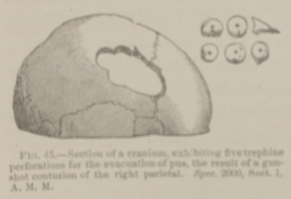Title: Resinger, Joseph
Source text: Surgeon General Joseph K. Barnes, United States Army, The Medical and Surgical History of the War of the Rebellion. (1861–65.), Part 1, Volume 2 (Washington, D.C.: Government Printing Office, 1870), 125.
Civil War Washington ID: med.d1e9117
TEI/XML: med.d1e9117.xml
RESINGER, JOSEPH, Private, Co. E, 151st New York Volunteers, aged 21 years, received, at the demonstration on Mine Run, Virginia, November 27th, 1863, a gunshot wound of the scalp, over the right parietal. He was conveyed to Fairfax Seminary Hospital. There was no cerebral disturbance at the time of his admission. The pericranium was not removed, and it was hoped that the skull had escaped uninjured. He was allowed to be up and about the wards, and no symptoms of any grave injury appeared until December 13th, 1863, when he was suddenly seized, while seated at the supper table, with convulsions, and became immediately unconscious. He was taken to his bed, and Surgeon D. P. Smith, U. S. V., laid bare the calvarium at the seat of injury, and applied the trephine. Pus was found immediately beneath the bone and oozed from the diploe. It was thought expedient to make five perforations with the trephine, in order to remove the diseased bone, and to give free exit to pus. Convulsions did not recur, but the comatose condition continued, and the case terminated fatally twelve hours after the operation. The autopsy revealed diffuse inflammation of the arachnoid and of the dura mater. The dura mater was not incised, as it did not bulge into the perforations made by the trephine. The pus proceeded altogether from the diploe and from between the dura mater and the skull. The specimen was contributed by the operator to the Army Medical Museum, and is figured in the adjoining wood-cut, (FIG. 45.)
